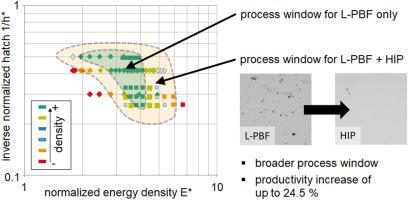Additive Manufacturing ( IF 10.3 ) Pub Date : 2020-08-05 , DOI: 10.1016/j.addma.2020.101494 Dirk Herzog , Katharina Bartsch , Bastian Bossen

|
Laser Powder Bed Fusion is today used for the serial production of parts, e.g. in the medical and aerospace markets. One of the major limitations is the comparatively low build rate of the process, which leads to low productivity and high costs when compared to conventional processes. Current approaches such as the use of multi-laser systems help increasing the build rate but come at higher investment costs. Overall, the low productivity limits the number of business cases for Laser Powder Bed Fusion and hinders the market uptake in more cost-sensitive industries.
This paper suggests a combined approach of Laser Powder Bed Fusion and subsequent Hot Isostatic Pressing as a method to improve productivity. Hot Isostatic Pressing is often used as a post-process to eliminate any remnant porosity. It is shown that the process, however, is able to densify specimens that come out of Laser Powder Bed Fusion with an as-build density as low as 95 %. This opens up a larger process window for the initial Laser Powder Bed Fusion step. Experimental investigations are presented using two commercial Laser Powder Bed Fusion systems with the widely used titanium alloy Ti-6Al-4V. Instead of optimizing the process for the highest possible density, the parameters were optimized to yield the highest possible speed while maintaining a density above 95 %. A scan speed increase of 67 % was achieved and the specimens were then successfully compacted to above 99.8 % density in the Hot Isostatic Processing step. The high-speed parameter set was then applied to a demonstrator build job, where it leads to an overall saving of 26 % of build time.
This research did not receive any specific grant from funding agencies in the public, commercial, or not-for-profit sectors.
中文翻译:

热等静压法优化激光粉末床熔合生产效率
如今,激光粉末床融合技术可用于零件的批量生产,例如在医疗和航空航天市场。主要限制之一是该方法的相对较低的构建速率,与常规方法相比,这导致较低的生产率和较高的成本。当前的方法(例如使用多激光系统)有助于提高构建速度,但会增加投资成本。总体而言,低生产率限制了激光粉末床熔合的业务案例数量,并阻碍了对成本更加敏感的行业的市场占有率。
本文提出了激光粉末床融合和随后的热等静压相结合的方法,以提高生产率。热等静压通常用作后处理,以消除任何残留的孔隙。结果表明,该方法能够以低至95%的建成密度对从激光粉末床融合中出来的样品进行致密化处理。这为初始的激光粉末床融合步骤打开了一个较大的处理窗口。使用两个商业激光粉末床融合系统和广泛使用的钛合金Ti-6Al-4V进行了实验研究。除了优化工艺以获取最高可能的密度外,还优化了参数以产生最高可能的速度,同时保持高于95%的密度。扫描速度提高了67%,然后在热等静压处理步骤中成功地将样品压实到99.8%以上的密度。然后,将高速参数集应用于演示程序的构建作业,从而节省了26%的构建时间。
这项研究未获得公共,商业或非营利部门资助机构的任何特定资助。











































 京公网安备 11010802027423号
京公网安备 11010802027423号